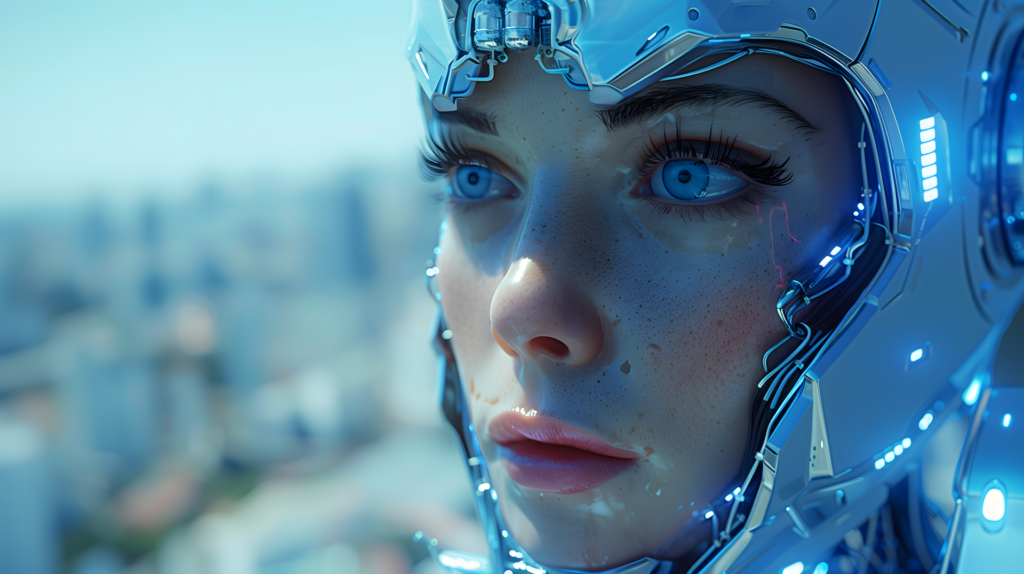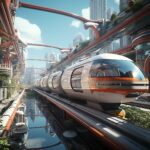
Introduction:
In the new way of Artificial intelligence (AI) and robotics once distinct fields are now converging at an accelerating pace giving rise to a transformative force known as AI driven robotics. This powerful type is reshaping industries, redefining human machine interaction and paving the way for innovations that were once confined to the realm of science fiction so far. In today’s world there where automation efficiency and intelligent systems are increasingly high, AI driven robotics is no longer a futuristic concept but a close to reality with profound implications. This article explores the current landscape of AI driven robotics and its key applications. The challenges it faces and the exciting possibilities that lie ahead.
Read also: Augmented Reality: Blending the Physical and Digital Worlds
1. The Current Landscape: Integration in Action
Today that we are witnessing a significant shift from the traditional and pre-programmed robots to intelligent machines capable of perceiving to learning and adapting to complex environments. AI algorithms particularly in areas like computer vision more like natural language processing and reinforcement learning are being seamlessly integrated with robotic hardware so far. This integration empowers robots to perform tasks that require dexterity and decision making and interaction with unstructured environments. In manufacturing, AI-powered robots can now identify defects with greater accuracy than human inspectors and even learn optimal welding paths through trial and error method. Similarly, in logistics the autonomous mobile robots (AMRs) equipped with AI navigate warehouses efficiently like optimizing routes and collaborating with human workers. The current scenario is characterized by this increasing adoption of intelligent and robots across various sectors moving beyond repetitive tasks to more dynamic and cognitive functions.
2. Key Applications Across Industries
The impact of AI driven robotics is being felt across the diverse range of industries in healthcare. Robotic surgery assisted by AI enhances precision and minimizes invasiveness. AI powered robotic assistants can aid in patient care medication management and even perform complex diagnostic tasks. Agriculture is being revolutionized by the autonomous robots and that can monitor crops and fields to identify diseases and perform precision planting and harvesting. This is to leading for increased yields and reduced resource consumption. The automotive industry has long embraced robotics for assembly of lines, but AI is now enabling the development of autonomous vehicles more promising safer and more efficient transportation. In retail robots are being deployed for the inventory management mostly customer service and last-mile delivery. Even in exploration and hazardous environments, AI-driven robots are proving invaluable for tasks such as deep-sea exploration, nuclear decommissioning and disaster response to minimizing risks for human personnel.
3. Advancements in Perception and Cognition
A critical enabler of AI driven robotics is the rapid advancement in perception and also cognition capabilities. Sophisticated sensors are including high-resolution cameras more like tactile sensors provide robots with rich environmental data. AI algorithms then to process this data for enable robots to understand their surroundings recognize objects and even interpret human gestures and emotions in nature. Natural language processing allows robots to understand and to respond the voice commands and engage in basic conversations. Furthermore to advancements in machine learning is particularly deep learning, enable robots to learn from vast amounts of data. Improving their performance over time and allowing them to handle increasingly complex scenarios by them. This enhanced perception and cognition are crucial for robots to operate autonomously and collaboratively in real world settings as an default.
4. Human-Robot Collaboration: The Rise of Co-bots
The narrative around the robotics is shifting from complete automation to collaborative robots or co-bots that work alongside humans. AI plays a vital role in enabling this collaboration. Co-bots are the well equipped with advanced safety features and the AI powered perception systems that allow them to sense human presence and movements. Ensuring safe interaction. They can assist human workers with physically demanding or repetitive tasks & freeing up human intellect for more complex and creative endeavors. This human robot collaboration enhances productivity, improves workplace ergonomics and leverages the strengths of both humans and machines. The deployment of co-bots in manufacturing then logistics and even more service industries is a significant trend in the current AI driven robotics landscape by its system.
5. Challenges and Ethical Considerations
Despite the immense potential the widespread adoption of AI-driven robotics is not that without its challenges. Technical hurdles remain in the areas such as robustness inunstructured of environments also energy efficiency and the development of truly adaptable and general-purpose robots. Furthermore in ethical considerations surrounding the job displacement is due to automation and data privacy are the potential for misuse of autonomous systems need careful attention and proactive solutions are needed. Ensuring fairness then transparency and accountability in AI algorithms that control robots is also a paramount. Addressing these challenges through ongoing research, robust regulatory frameworks and open societal discussions is crucial for realizing the real benefits of AI driven robotics is responsible.
6. The Future Trajectory: Towards Embodied Intelligence
Looking ahead the future of AI driven robotics points is towards the development of an increasingly sophisticated and versatile machines with an termed “embodied intelligence.” This envisions robots that not only perceive and process information but also possess a deeper understanding of the physical world and can interact with more nuanced and intuitive ways to know more. We can expect advancements in areas like haptic feedback and allowing for more realistic robotic manipulation in the development of more human like forms and movements. Furthermore the integration of AI with advanced materials and soft robotics could lead to robots capable of navigating complex in more delicate environments. The future also holds the promise of greater autonomy with robots capable of making more complex decisions and operating the extended periods without human intervention.
7. The Impact of Edge Computing and 5G
The continued advancement and integration of technologies like the edge computing and then 5G networks will significantly accelerate the capabilities of an AI driven robot. Edge computing which processes data closer to the source and that will reduce latency and enable faster real time decision making for robots operating in dynamic environments. This is particularly crucial for the applications like autonomous vehicles and the industrial automation where it immediate responses are critical. The high band width and low latency of 5G networks will be facilitate seamless communication between robots and cloud based AI systems for human operators. Enabling more sophisticated control over remote monitoring and collaborative functionalities. These technological enablers will pave the way for more intelligent than responsive and interconnected robotic systems.
Conclusion:
AI-driven robotics stands at the cusp of a new era, promising to revolutionize the way we live and work. From enhancing efficiency in industries to assisting in healthcare and exploring uncharted territories, the integration of artificial intelligence with robotic systems is already delivering tangible benefits. Embracing this symbiotic future requires continuous innovation, proactive policymaking, and a willingness to adapt to the transformative power of AI-driven robotics.
Buy Now
Quantum Computing for Computer Scientists

